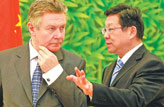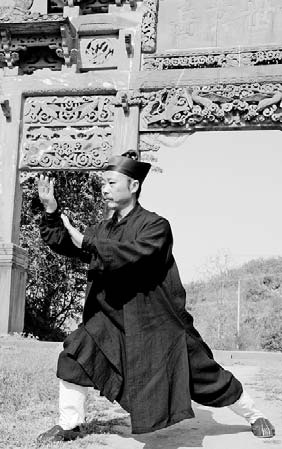Life
Taoist monk finds his path as he masters martial art
Updated: 2011-07-18 14:19
By Xu Lin (China Daily)
|
Kungfu masters enjoy a state of quietness and seldom fight, says Zhong Yunlong. Xin Lin / China Daily |
On a sweltering afternoon, a group of young men in white robes are practicing kungfu in a backyard. A man is hitting another man's exposed back with a long, thin sandbag. The man who gets beaten never moves and screams each time when the sandbag hits him. His back soon becomes red.
They are all disciples of kungfu master Zhong Yunlong, 47, leader of Wudang's Sanfeng faction.
"They are practicing how to take beatings. Running away and taking a beating are basic parts of Chinese martial arts, in case one loses a fight," says Zhong, a bearded man who wears a Taoist hat and black robe.
Zhong has practiced martial arts, including qigong and taichi, for more than 40 years. He is dedicated to promoting Wudang kungfu.
He started to teach in 1987 and established his own school at the foot of Wudang Mountain in 2010.
He recalls that senior Taoist monks had a tradition to teach kungfu at midnight, because they would only pass on the unique kungfu to the most diligent students.
After one day's study of martial arts, some disciples would get up at midnight and continue practice.
Although Zhong doesn't teach his disciples at midnight now, he believes diligence is one of the most important traits for his students.
He plans to train about 30 disciples from impoverished areas, providing free accommodation, food and uniforms.
"Kids from poor families can bear hardships and concentrate more on kungfu. They will teach martial arts fans from home and abroad after two years' training," he says.
Zhong believes the study of kungfu is a lifetime pursuit, and it may take 20 years to be a real kungfu master.
"Traditional Chinese kungfu is to attack vital parts, such as the throat. It's like warcraft: One may lure the enemy to move in a way so that one can attack these parts," he says.
Zhong says that's why Taoist kungfu practitioners, who tend to enjoy a state of quietness, seldom fight. However, many kungfu beginners went to Wudang looking for competition when the Taoist temples on the Wudang Mountains reopened to the public in 1984.
Zhong remembers a summer afternoon in 1988, when a man armed with a sword came to the Purple Cloud complex, where Zhong and other disciples lived. As most Taoist monks were taking a nap at that time, he couldn't find anyone to fight with and began to mutter insults.
Zhong met the man and defeated him within a few minutes.
"I can quickly end a fight, but normally I don't fight unless it is necessary. Even when I have to, I never use my full strength. We don't want to hurt others," he says.
Zhong left his hometown in Hubei province for Jiangxi province to study Chinese boxing at the age of 13.
After watching the box office hit The Shaolin Temple starring Jet Li, he went to the famous Shaolin Temple to study martial arts in 1982.
One year later, he arrived at the Wudang Mountains, learning martial arts from elder Taoist monks and becoming one himself. He also traveled around China to visit other kungfu masters.
"Kungfu students like to learn from each other, no matter which faction we are from. To study kungfu is more about cultivating one's mind than using it in a fight. I only teach kungfu to those who are really fond of it," he says.
You can contact the writer at xulin@chinadaily.com.cn.
China Daily
(China Daily 07/17/2011 page4)

Specials

China-US Governors Forum
The first China-US Governors Forum is held July 15 in the Salt Lake City, the United States.

My China story
Foreign readers are invited to share your China stories.

Rare earths export quota
China kept its export quota at almost the same level as last year.
